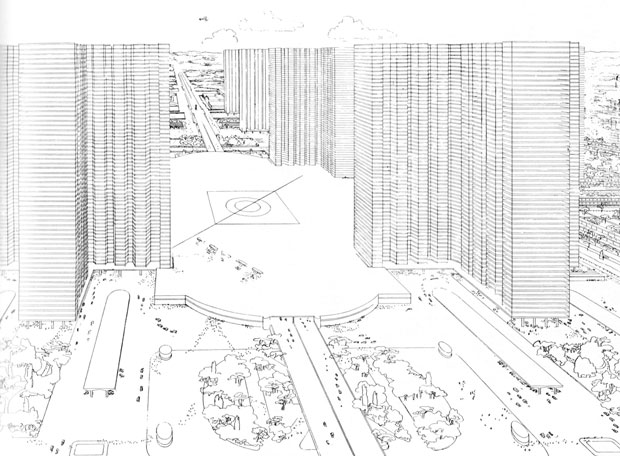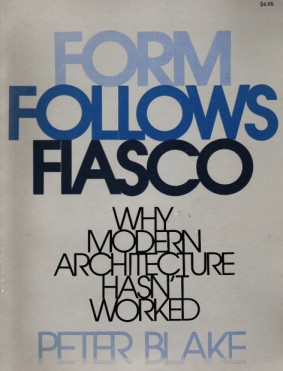Form Follows Fiasco is a polemic against modern architecture written by an accomplished modern architect. The crux of Blake’s argument is that his colleagues in architecture (and other design-related fields) have lost sight of who they’re building for: people. If the modernists’ mantra was “form follows function,” then they quickly became infatuated purely with form, designing lovely but unsittable chairs, handsome but unreadable watches, and gorgeous but unlivable buildings. Most of Blake’s arguments are anecdotal. Clearly, not every modern building (or watch or chair for that matter) is a disaster. But Blake has designed over 50 modern buildings; written a paean to the modernist masters Le Corbusier, Mies Van Der Rohe, and Frank Lloyd Wright; and edited Architectural Digest; so his defection is not to be taken lightly, and his indictments of are rooted in experience. The book’s eleven chapters each take on a central tenet (Blake calls them “fantasies”) of modern architecture, tenets that the author sets out to prove are out-of-touch with the realities of construction, economy, and human well-being.

Blake saves special vitriol for high-rise buildings–which he argues are tools of real-estate speculation–and the modernist architects who provide their aesthetic justification. Because of their height, high-rises are the best way to squeeze maximum rent out of every square foot of ground, but they tend to suck the life out of their vicinity. They are hostile to the local economy, as a block of small businesses gets pushed out in favor of a massive corporate flagship store or two. They are hostile to pedestrians, since their tall, flat faces deflect wind down toward street-level, disrupting pedestrian circulation and making outdoor restaurants and cafes infeasible. They are hostile to neighboring buildings: high-rises need deep foundations and basements to provide for stability against the wind, but to keep their basements dry they must pump water out, lowering the water table and compromising the foundations of nearby (especially older) buildings. And ultimately, high-rises increase population density, which creates an across-the-board need of more infrastructure (water, gas, waste disposal, mass transit, etc.), all paid for by taxpayers (of which high-rise residents and owners are a small fraction). In all these ways, skyscrapers are a prime example of cost externalization. Their profitability comes at the expense of their neighbors and taxpayers.
And there’s also their symbolic cost. Architect Constantinos Doxiades, who felt that his “greatest crime was the construction of high-rise buildings,” reflected thus:
(skyscrapers) destroy the urban landscape by eliminating all values which existed in the past. Human symbols–such as churches, mosques, temples of all kinds, city halls, which once rose above the city–are now below the skyscrapers. We may not agree that God or government should rise above man, but are we ready to agree that symbols of capital gain should rise above all else? (82)

Ideal Cities
Above is a drawing of Le Corbusier’s Ville Radieuse, or Radiant City. It was an ideal, never built, but which served as inspiration for several real-world places like the Unité d’Habitation in France and the city of Algiers in French North Africa. Le Corbusier imagined his Radiant City in 1924, at a time when the first skyscrapers were raised. One can imagine his enthusiasm: suddenly new kinds of buildings were possible, massive, densely-populated edifices able to house maximum humans in minimum space, enabling a degree of order and organization unseen in cities before. But the people in Le Corbusier’s drawings are always absent or insignificant, and I get the feeling that they weren’t Le Corbusier’s primary concern.
In Blake’s analysis, I sense two models for cities: the mechanistic and the organic, and every city is in tension between the two. At the far end of the organic model are slums: spontaneously emerging communities which, while disorganized, are impressively self-sustaining. If there is need for a shop, someone will open one where it is needed, zoning boards and business licenses be damned. At the other end of the spectrum I think we find the Radiant City and other modernist utopia: highly-organized, strictly zoned–“immensely rational machine[s]” (66). This model may make for efficient cities, but what of human happiness? Do we really want to live inside rational machines? The alternative need not be slums, but at least the spontaneity and delightful disorder of little city streets. “The urbanists of the Modern Movement rejected the street when it became an ‘urban sewer,’” Blake recounts, but our city streets can and need to be “places of intimacy and of interaction rather than…landscaped wastelands of alienation” (96). Everything I love about Greenwich Village–the street vendors, small shops, cafes, and theaters–I see none of it, or even the possibility of it, in Le Corbusier’s Radiant City. In Blake’s words:
the most impressive quality that our cities used to possess…was, quite simply, infinite variety. Within the same city block, sometimes within the same city building, one might encounter apartments, workshops, stores, schoolrooms, offices, studios, places of worship, theaters, warehouses, restaurants, bars, and even governmental outposts… The ideal city block–in terms of life as it is lived, not life as it can be designed–is a capsule travelogue of our time, and of all the times that preceded and helped to shape it (116)
Breaking with History
Americans today take the availability–and indeed, the necessity–of the automobile for granted. But from about 100,000 B.C. until the middle of the twentieth century, human beings lived, worked, and played in roughly the same place, and when circumstances called for drastic movement, we walked (only the lucky few owned horses). Blake argues that ideal cities–like all cities until this point in history–“are pedestrian cities: dense concentrations of people and of many varied activities, including good schools, good jobs, and good fun, which will make most mechanical transportation systems rather unnecessary” (103). He invites us to see the need for transportation as a failure, rather than a precondition, of the design of cities; as a sign that we’ve packed people too tight and too far from sources of education, employment, and enjoyment.
Blake attacks single-use zoning on similar grounds. For as long as there have been cities, people have started shops, schools, and taverns where they pleased (or, more importantly, where they were needed). The downtown business district and its necessary counterpart, the suburban residential zone, are strictly modern conventions. The commuting necessitated by this arrangement degrades the environment and costs commuters time with their families, psychological stress, and a financial burden. And this says nothing of the cost to the city itself–to us the taxpayers–of letting Manhattan’s Financial District lie dormant 2/3 of the time, a huge waste of the infrastructure that supports it. I find Blake’s view compelling that ideal cities are 24/7 cities, where no neighborhoods die at 6:00 p.m. Where you get out of work and, instead of an endless sea of miserable faces bustling to catch their trains, you might see kids in the park, couples being seated to dinner at sidewalk cafes, and retired folks out for a stroll.
For designers (of cities or anything, really), Form Follows Fiasco is a lesson in never letting high ideals distract you from the needs of who you’re designing for. But for the people who have to live with the design decisions of others, the book is a powerful reminder that there is nothing normal, or natural, or necessary about the way things are. We live on a drawing board, and whether you’re an architect, a property owner, or just a voter, ask yourself: in what kind of place do I want to live?
